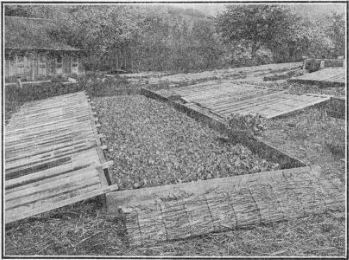218. The Use Of Mats
Description
This section is from the book "Vegetable Gardening", by Ralph L. Watts. Also available from Amazon: Vegetable Gardening.
218. The Use Of Mats
Mats are essential in the frame culture of early vegetable plants in the North, although double glass sash are used without mats in the milder sections. Mats should be placed on the sash about 4 o'clock in the afternoon in cold weather, and later in the day as the spring advances; but they should not be removed in the morning until the temperature outside is rising, and in very cold weather it may be best not to remove the mats at all from cold frames for a few days or even as long as a week in extreme cases. In March there may be heavy falls of snow with zero weather for many days, with little or no sunshine. Under such conditions it is better not to remove mats. While the plants do not grow when thus excluded from the light, they will not be injured by close confinement at low temperatures.

Fig. 42. frame of hardened cabbage plants.
The durability of straw mats depends largely upon care. When deep snow covers the mats, it should be shoveled off before an attempt is made to remove them. When they are wet or covered with an inch or two of snow, the best way to remove them is to walk along the lower side of the frame, grasp the mats at the cords and double them over as far as possible toward the other side. Then go to the upper side of the frame and draw off the mats by taking hold of the lapped-over ends. If wet, they should be spread flat on the ground or, better still, supported on a fence to facilitate drying. To cover the frames in the evening when the mats are wet, proceed as follows: Walk on the mat, reach backward, clasp the far end with both hands, walk over the frame at a crossbar and drop the mat in place. When dry, they are handled rapidly and with ease.
Mats are also useful in shading plants. The glass may be covered entirely in hot weather, or the opposite edges of the mat may be turned back, exposing 6 to 12 inches of glass along each side of the frame. This method of shading is especially valuable when transplanting is done late in the spring.
Continue to:
Tags
plants, crops, gardening, cultivated, harvesting, food ,greenhouses, fertiliser, vegitables
